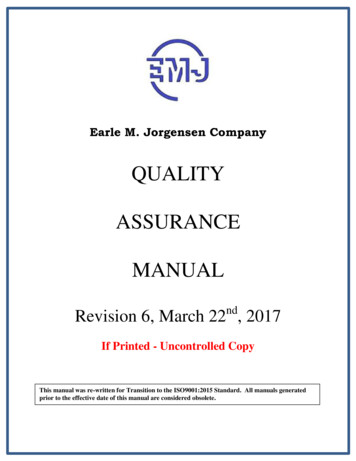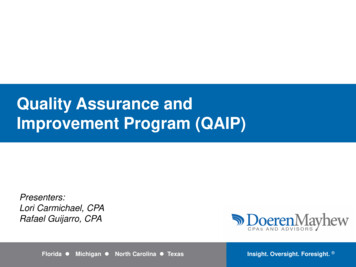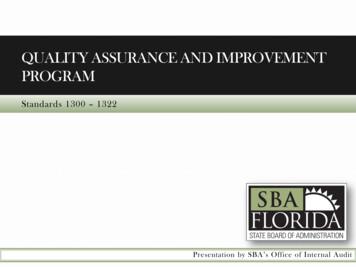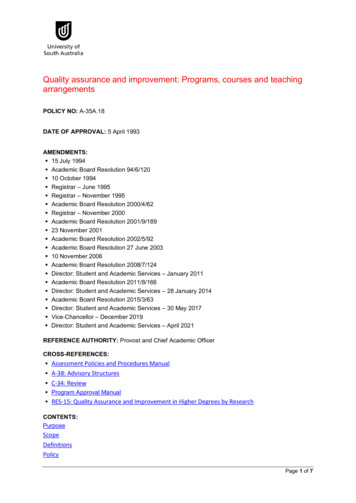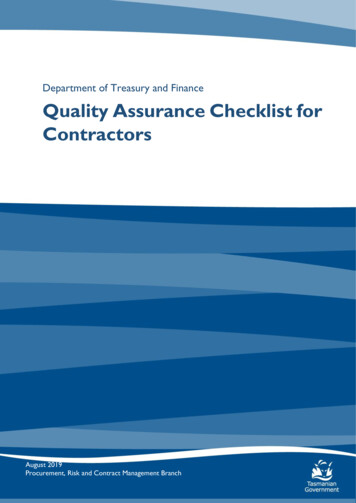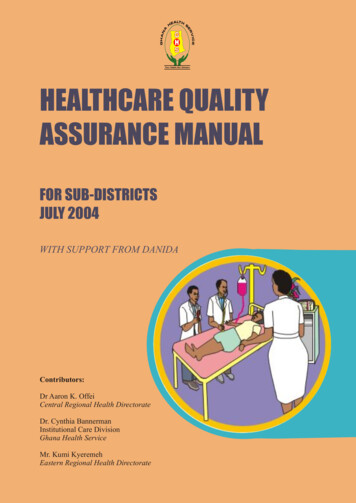
Transcription
HEALTHCARE QUALITYASSURANCE MANUALFOR SUB-DISTRICTSJULY 2004WITH SUPPORT FROM DANIDAContributors:Dr Aaron K. OffeiCentral Regional Health DirectorateDr. Cynthia BannermanInstitutional Care DivisionGhana Health ServiceMr. Kumi KyeremehEastern Regional Health Directorate
HEALTHCARE QUALITYASSURANCE MANUALFOR SUB-DISTRICTSJULY 2004WITH SUPPORT FROM DANIDAContributors:Dr Aaron K. OffeiCentral Regional Health DirectorateDr. Cynthia BannermanInstitutional Care DivisionGhana Health ServiceMr. Kumi KyeremehEastern Regional Health Directorate
PREFACEPatients and Clients often complain about poor quality ofservices in our health facilities.Poor quality is costly; it leads to loss of lives, loss of time, lossof public confidence, low staff morale and also results inwastage of our limited resources.The Ghana Health Service has as one of its main objectives, theimprovement in quality of care at all service delivery points. Itis the responsibility of all health workers to help achieve thisobjective.This manual was written by local experts for health workersespecially those delivering service at the sub-district level toprovide them with the essential knowledge and skills to planand implement quality assurance in their health facilities.For those in the sub-district this manual will:?Introduce them to the concept of quality and itscomponentsProvide practical steps to implement QualityAssurance at the sub-district levelIt is also a useful manual for in-service and pre-service trainingprogrammes. The manual will also be useful as a referencedocument.Professor Agyeman Badu AkosaDirector GeneralGhana Health Serviceiii
ACKNOWLEDGEMENTSThe authors are grateful to the Director General of the GhanaHealth Service, Professor Agyeman Badu Akosa for entrustingthem with the assignment of writing this manual.We also thank the Danida Health Office in Accra for providingfinancial support to the project. We are particularly grateful tothe Senior Health Advisor, Dr Kobina Bainson for his usefulsuggestions.The authors would like to express their profoundappreciation to Mr. Albert Kobina Koomson, Director of theCentre For Continuing Education, University Of Cape Coast(CCEUCC) for his guidance during the development of themanual and Mr. R. Y. Essiam also of CCEUCC, for providingthe illustrations in the book.The authors are also grateful to those who read through thedraft manual and offered invaluable suggestions. They areJustice Hafoba, Dinah Baah-Odoom, Florence Offei, Dr. S. M.Zakariah and Bertha Boakye Agyeman.Finally, we are looking forward to receiving comments fromhealth workers who use the manual . Their feedback will go along way to help improve on future reviews.iv
TABLE OF CONTENTSPREFACEACKNOWLEDGEMENTSLIST OF FIGURESINTRODUCTION TO THE MANUALCHAPTER 1: THE CONCEPT OF QUALITY1.0Introduction1.1What is quality?1.2What is quality of care?1.3Components of quality health services1.4Perspectives of quality1.5Other ways of understanding qualityiiiivviiviii1112356CHAPTER 2: THE CONCEPT OF QUALITY ASSURANCE (QA)2.0Introduction2.1What is quality assurance?2.2Principles of quality assurance2.3Benefits of quality assurance2.4Cost of poor quality88891315CHAPTER 3: ORGANIZATIONAL LEVELS FOR QA3.0Introduction3.1National Level3.2Regional Level3.3District Level3.4Facility Level171717181819CHAPTER 4: RELATIONSHIP WITH OUR CLIENTS4.0Introduction4.1Who is a supplier?4.2Who is a client?4.3The role of Client in quality assurance2121212124CHAPTER 5: STANDARDS5.0Introduction5.1What is a standard?5.2Types of standards5.3Uses of standards5.4How do staff get to know about standards?262626272729CHAPTER 6: MONITORING AND SUPERVISION6.0Introduction6.1What is quality monitoring?6.2Methods for monitoring quality30303031v
6.36.46.56.66.76.8Client satisfaction surveyClients complaints systemRecords reviewReview of adverse incidenceMystery ClientSupervision313334353535CHAPTER 7: TOOLS FOR QUALITY MONITORING7.0Introduction7.1Indicators7.2Tools for collecting data7.3Dissemination of quality information3737373940CHAPTER 8: QUALITY IMPROVEMENT8.0Introduction8.1Quality assurance cycle8.2Steps in the Quality Assurance Cycle43434343CHAPTER 9:9.09.19.249494951IMPLEMENTING QA IN THE FACILITYIntroductionSteps in the implementation of QAThe role of the health care manager in QA implementationCHAPTER 10: MANAGING CHANGE10.0Introduction10.1Types of change in an organization10.2Reactions to change10.3Strategies for managing change10.4Ways to minimize resistance when implementing change535353545555APPENDICES1A.Sample patient satisfaction survey questionnaire1B.Sample checklist (Adapted from Upper West Region)1C.Sample observation guide with ratings2.Calculation of patient defined indicators3.Glossary of common terms575758596062REFERENCES65vi
LIST OF FIGURES123Illustrating quality of objectsClimbing steadily to achieve excellence in qualityOPD Attendance for Health Facilities inCape Coast District.2002 (Bar Chart)4OPD Attendance for Health Facilities inCape Coast District.2002 (Pie Chart)5Trend of MMR in Central Region. 1996-2002 (Line Graph)6Interaction among health workers and the Community7A happy Patient8A smart nurse showing satisfaction with her work9A beautiful compound10 Receiving an award for best health facility11 A very sick patient12 A dissatisfied patient13 A Nurse expressing satisfaction with the service of aDispensary Staff14 A patient receiving drugs from the dispensary15 Patients listening attentively to health talk at the OPD16 Health workers-community interaction17 A Nurse attending to a patient18 Quality Gap between present and expected standard19 A graph of Drug availability20 Interviewer sitting with interviewee21 The Suggestion Box22 At the Complaint desk23 A client receiving advice from a staff24 Yardstick for measuring staff attitude25 Climbing the steps of quality standard26 All patients should be seen promptly27 An example of QA Monitoring28 Briefing about the performance of the service29 Quality Assurance Cycle30a Why is the compound dirty? But why30b Offei Tree31 Looking into several documents32 Manager providing leadership33 Calming down the fears of workers' reaction to 3738394141444546485154vii
INTRODUCTION TO THE MANUALPatients often complain about the poor quality of the services they receive at our healthfacilities. Poor quality causes loss of lives, loss of revenue, low morale among healthworkers and poor image of health care providers.In Ghana, improving the quality of healthcare is a key objective of the Ministry ofHealth and the Ghana Health Service. One of the strategies for achieving this is throughthe implementation of quality assurance programmes in all health facilities. It isenvisaged that quality assurance will become an integral part of routine health servicedelivery in GhanaQuality Assurance (QA) started in the Eastern and Upper West regions with thesupport of Liverpool School of Tropical Medicine and Danish InternationalDevelopment Agency (DANIDA). Most of the regions have quality assuranceprogrammes although they are all at different stages of implementation. However, theImplementation of quality assurance at the sub-district level is rather low.This manual is targeted at health center and clinic staff at the sub-district in both theprivate and public sectors. Its main objective is to raise awareness about the importanceof quality assurance in everyday work situations. It focuses on essential knowledgeneeded to plan and establish quality assurance in the health facility. It is also useful forthe training of health workers at the sub-district level.The manual is useful in the training of staff involved in both clinical and public healthactivities. Health training institutions will find it beneficial in the teaching of theconcept, principles and processes of quality assurance. The manual is also a usefulguide for managers supervising the implementation of quality assurance programmesChapters 1 and 2 looks at Quality and Quality Assurance.Chapters 3 and 4 discuss the role of health providers and clients in Quality Assurance.Chapters 5,6 and 7 shows how we can monitor quality and improve on the care we give.Chapters 8,9 and 10 discuss how to improve and sustain quality in the delivery of healthcare.Chapter 8 teaches us the steps involved in improving quality.Chapter 9 shows us how to implement QA in the clinics.Chapter 10 discusses how to get every member of staff involved.viii
1THE CONCEPT OF QUALITY1.0IntroductionOur patients/clients and the general public often complain about the poor quality ofcare in our health facilities. We often hear on the radio, television and even in thecommunity about the poor quality of care that patients have received from us. Weourselves experience this poor quality in our health facilities when we are sick.Although we have few resources and may be short of staff, we can do something aboutthe poor quality of healthcare.At the end of this chapter you will be able to? Explain what quality means? Explain the meaning of quality of careState and explain the various aspects of quality health service?Discuss the patient's/client's, health manager's and health worker's view about?quality1.1What Is Quality?To the ordinary person, quality is how good something is. This may be a service e.g.canteen service or a product eg. wrist watch. A person's judgement about a service orproduct depends on what he expects of it or from it. Some of the words used to describequality are:Beautiful or attractive?Durable?Meeting standards?Healthy?Value for money?Although different words are used to explain quality, we would define it as the extent towhich a product or service satisfies a person or a group i.e. how much satisfaction theperson gets from the service.1
A: A Healthy and an unhealthy dogB: A fresh and rotten orangesC: Disordered and neatly arranged tablesD: Thatch structuresE: Beautiful building withwell-kept environmentFig. 1: Different structures showing levels of qualityPeople's expectations differ. Therefore, what Ama expects from a service may bedifferent from what Kofi expects of it. Also with time, Ama's expectations may changetherefore it is very important that we keep on improving on the quality of our services1.2What is Quality of Care?When we say quality of care, we mean healthcare activities that we in the medical,nursing, laboratory fields etc. perform daily to benefit our patients without causingharm to them. Quality of Care demands that we pay attention to the needs of patientsand clients. We also have to use methods that have been tested to be safe, affordable andcan reduce deaths, illness and disability. Furthermore, we are expected to practiceaccording to set standards as laid down by clinical guidelines and protocols.2
With Quality of Care we do the right things atthe right time. We see to patients promptly,make the right diagnosis and give the righttreatment. With quality of care we keep onimproving on our standard of services tillexcellence is attained.1.3Components of Quality HealthServicesQuality health service has several parts. We needto understand these in order to improve qualityof care. The parts are listed in the box below. Weshall look briefly at each of the parts.AccessEfficiencyTechnical tiesFig. 2: Climbing steadily towardsachieving excellence in quality1.3.1 Access to ServiceEveryone should have access to quality health care. Access refers to the ability of theindividual to obtain health services. Some of the factors that can affect access are:a) Distance: e.g. where health facility is sited far away or it is difficult to get transport tothe facility access to quality health care becomes a problem.b) Financial: e.g. where people cannot pay for the services provided.c) Culture, beliefs and values: The services provided may not be in line with the culture,beliefs and values of some people.1.3.2 Technical CompetenceTechnical competence as an indicator of quality assurance implies that we should haveadequate knowledge and skills to carry out our functions in order to provide qualityservice. E.g. one must go to a nursing school and pass the nursing examinations beforeshe can work as a nurse.Even though we are no longer in school, we have to continue to update our knowledgeby reading health books and attending in-service training workshops etc.3
As health professionals, we should also know our limits, that is, know what we can doand what we cannot do. With respect to what we cannot do, we are expected to referthem to other centres or personnel who are more competent to handle them.Our practice should also be guided by laid down standards and guidelines e.g. StandardTreatment Guideline.1.3.3 EquityQuality services should be provided to all people who need them, be they poor, children,adults, old people, pregnant women, disabled etc. Quality services should be availablein all parts of the country, in villages, towns and cities.1.3.4 EffectivenessWe are interested in the type of care that produces positive change in the patient's healthor quality of life. We therefore use treatments that are known to be effective, for example,giving a child with diarrhea Oral Rehydration Salt (ORS)1.3.5 EfficiencyEfficiency is the provision of high quality care at the lowest possible cost. We areexpected to make the best use of resources and avoid waste of our scarce resources. Wewaste resources by :? prescribing unnecessary drugs? stocking more drugs than is required and making them expire? buying supplies and equipment we do not useWhat happens when we stock more drugs than is required?1.3.6. ContinuityContinuity means that the client gets the full range of health services he/she needs, andthat when the case is beyond us, we refer him/her to the right level for further care.Continuity may be achieved by the patient seeing the same primary health care workeror by keeping accurate health records so that another staff can have adequateinformation to follow up the patient.1.3.7 SafetySafety means that when providing health services, we reduce to the barest minimuminjuries, infections, harmful side effects and other dangers to clients and to staff. Inproviding quality care, we should not put the patient's life at risk. For example, weshould not give unsafe blood to patients and thereby infect them with HIV/AIDS.4
1.3.8. Interpersonal RelationsIt refers to the relationship between us and our clients and communities, betweenhealth mangers and their staff.We should:? show respect to our clients;? feel for our patients;? not be rude or shout at them;? not disclose information we get from patients to other people.These will bring about good relations and trust between the clients/communities and us.Clients consider good interpersonal relationship as an important component of qualityof care.1.3.9 AmenitiesThese are features that can be provided by our health facilities to make life comfortableand pleasant for clients. They contribute to clients' satisfaction and make clients willingto use our services. For example, comfortable seats, television sets, music, educationalmaterials, educative video films, etc. at the OPD and wards.1.4Perspectives of QualityThe health staff, health manager, clients and communities are all stakeholders in servicedelivery. Each of these groups may expect different things from health services.1.4.1 The Patient/ClientResearch done in various parts of the country shows that our patients/clients wantservices that:?are delivered on time by friendly and respectful staff;are safe, produce positive result and that they can afford;provide them with adequate information about their condition and treatment;provide them with all the drugs they need;give privacy.are within their reach (distance) and given in a language they can understand.1.4.2 The Health Staff ProviderThe health provider can provide quality care if he/she has:? adequate knowledge and skills.? enough resources- staff, drugs, supplies, equipment and transport etc? safe and clean workplace.? opportunity to regularly improve himself/herself.? is well paid and rewarded for good work.5
1.4.3 The Health Care ManagerThe health care manager sees quality care as:? managing efficiently the resources of the health facility.? health staff achieving set targets.? health staff being regularly supported and supervised.? having adequate and competent staff to provide care.? staff being disciplined.? providing enough resources for work.1.5 Other ways of understanding QualityWe will now look at some other ways of understanding quality. Quality of care can alsobe seen from the inputs, processes and outcome of service delivery. We have to addressthese together to improve on quality.Most of the time we only complain about lack of inputs without also looking at how wedo things or activities that we carry out.1.5.1 InputsThese are materials needed to provide care. Examples include staff, drugs, buildingsand equipment.1.5.2 ProcessThis refers to what is done and the way things are done. An example is the activities foroutpatient care. The patient has to make a card, go to the screening table for his/hertemperature and blood pressure to be taken. He/she then goes to the consulting roomafter which he/she goes to the dispensary for drugs.1.5.3 Output/OutcomeIt is the results we get out of health service delivery. For example, is the client satisfiedwith the service he/she gets after visiting our facility? Has there been a decrease inoutpatient attendance?Answers to the two questions are indications of output/ outcome of our health servicedelivery.6
Chapter SummaryIn this chapter, we have discussed the meaning of quality from differentangles.We can look at quality from its various components or parts-access,technical competence, amenities, equity, efficiency, effectiveness,safety, continuity of services and interpersonal relationship.We can also explain quality from the point of view of the perspectives ofvarious stakeholders in health care-the patient/client, the health staffand the manager.Quality can also be discussed from the inputs, processes andoutput/outcomes of service delivery.ExerciseFrom your outpatient services, make a list of things that can beconsidered under the following headings; Inputs, Processes,and Outputs. Show how the listed factors affect health servicedelivery.7
2THE CONCEPT OF QUALITY ASSURANCE2.0IntroductionWe now know what quality of care means, the different components and the differentviews. In this chapter, we will learn about quality assurance, the benefits and barriers toquality assurance. We shall also learn about the cost of poor quality.When you go through this chapter, you should be able to:?explain what quality assurance is?describe the five principles of quality assurance?discuss the benefits of quality assurance?discuss the cost of poor quality that occurs in your health facility.2.1 What Is Quality Assurance?Quality Assurance (QA) started long ago in Japanese industry. It was realized thatthrough inspection, more faulty products were detected but the quality of the productsdid not change. It became necessary therefore to look at the ways products were madeso that any changes can be made along the line before the finished product came out.Therefore quality assurance was adopted from industry into the health care setting inthe developed countries. It has really helped in improving quality of care in thesecountries. Now we in Ghana have also adopted quality assurance to improve healthservice delivery.Quality Assurance is a set of activities that are planned for, carried out systematically orin an orderly manner and continuously to improve quality of care. It involves:?The setting of standards;?Monitoring to see if there is a gap between what is being done now and what isexpected; and addressing the gap on a regular basis (quality improvement).8
Quality Assurance encourages health workers to examine the services they provide,assess their own work and come out with what they can do with the limited resources toimprove the quality of care.For supervisors and managers, QA calls for change from the status of an inspector tothat of a facilitator, and expects the health workers to identify and solve problems.Quality Assurance also requires that health workers understand the needs of patientsand their communities in order to provide for them.Quality Assurance requires active support and commitment from leaders at thenational, regional, district, sub-district levels and in the health facilities.2.2Principles of Quality AssuranceThere are five basic principles of quality assurance. These principles, as stated below,clearly show what QA is intended for.1.2.3.4.5.Quality Assurance is oriented towards meeting the needs andexpectations of our clientsQuality Assurance focuses on systems and processesQuality Assurance uses data to analyze service deliveryQuality Assurance encourages the use of teams in problemsolving and quality improvementQuality Assurance uses effective communication to improveservice deliveryAdapted from QAP2.2.1 Meeting the Needs of Our Clients - Principle 1The people we provide health services for are very important to us. Without them, wewill not be in employment. Therefore we must do our best to satisfy them. In the past,we worked as if the clients did not matter so we did not involve them in healthcare,neither were their needs in service delivery addressed. With QA, the situation is nowchanging. All over the world, patients concerns regarding their rights to participate inhealthcare delivery are becoming important. The clients are the main focus in qualityassurance programmes.There are two types of clients. These are internal and external clients. The external clientsinclude people who directly use our services and those who have special interest in ourservices. They are made up of patients, relatives and friends and the community as wellas other organizations: Non-Governmental Organisations (NGO's), District Assemblies,Ministries, Development partners (Donors) etc.9
The internal clients are the workers in the health facility. Their needs must also be cateredfor so that they can provide quality care. We will discuss more about clients in chapterfour. We can assess our client's needs either through surveys (interviews) or discussionswith individuals and groups within the community who use our services. The clientsare in the best position to say what constitutes quality to them. They tell us whether weare meeting their expectations through client surveys, community meetings, focusgroup discussions etc.2.2.2 Focusing On Systems - Principle 2Systems are the various aspects or components of service delivery that have to operatetogether as a unit in a facility to deliver quality health care. The three components ofservice delivery; namely; inputs, processes and outcomes have already been explainedin section 1.5. When things go wrong with health services we often blame the staff.Whilst this may be true to some extent, in most cases, the problems lie in all the areas ofservice delivery.In QA also, we address problems by looking at all the three areas - inputs, processes, andoutcomes at the same time.2.2.3 Use of Data to Improve Quality - Principle 3We collect a lot of information (data) in our health facilities but we just send them on tothe District Director without making use of them. Some of the data we collect includethe number of people who attend the OPD, their age and sex. We also collectinformation on the number of cases of malaria, diarrhoea, mothers dying frompregnancy, delivery and after delivery.These data are very useful. They can tell us where there are problems in service delivery.We can use the information in planning services and for monitoring. Data can also beused in identifying resources (people, drugs and supplies as well as the amount ofmoney) required for health services.We must analyze data and use it locally to improve services; some of these data can beshared with community members.Sources of DataThere are different sources from which we get data, they include the healthmanagement information system, surveillance system and surveys.a) Health Management Information System (HMIS): - This is the system set up to collectroutine information from health facilities. This includes information from dailyoutpatient registers, child welfare clinics, admission and discharge registers.10
b) Surveillance System: - The Public Health division also collects data on communicableand non-communicable diseases throughout the country. Some of the data collected areon Malaria, Diarrhoea, Acute Respiratory Infection, Immunization, Buruli ulcer,Tuberculosis, Guinea worm, Cerebrospinal meningitisc) Surveys: - These are done periodically to obtain information that are not available inthe routine data that are collected. The Ghana Demography Health Survey collects dataevery five years on fertility, mortality and morbidity.Data PresentationThe data we collect can be analyzed and summarized and presented in simple formsthat make them easier to understand. Some of the forms include Bar charts, Line graphsand Pie charts which are shown below.A/ Example of a bar chart showing attendance at health facilities in Cape Coast 48504000300020008741100023240CAPE COAST CENTRAL REGIONAL UNIVERSITYHOSPITALHOSPITALHOSPITALEWIM URBANADISADELHEALTH CENTRE HEALTH CENTREEFUTU CLINICFig. 3: OPD Attendance for Health Facilities inCape Coast District. 2002B/ Example of a Pie Chart showing OPD attendance of facilities in Cape CoastADISADELHEALTH CENTRE5%EWIM URBANHEALTH CENTRE13%UNIVERSITYHOSPITAL21%EFUTU CLINIC1%CAPE COASTHOSPITAL21%CENTRAL REGIONALHOSPITAL39%Fig. 4: OPD Attendance for Health Facilities inCape Coast District. 200211
C/ Example of a line graph showing trends in maternal mortality rate over the years7Rate (Per 1000LB)65432101996199719981999200020012002YearFig. 5: Trend of MMR in Central Region.1996 2002When data is properly analyzed and the information obtained is very useful, it helps us to:? See trends in service delivery e.g. if OPD attendances are decreasing orincreasing;? Know whether we have achieved our targets;? Know where there are problems in service delivery.2.2.4 Improving Quality Through Team Work - Principle-4A team is a group of people who work together to achieve a common goal. In healthservice delivery we have different kinds of health workers working together. Let's usethe outpatient services as an example of teamwork. There are labourers to clean theunit, records officers to register the patient, nurses to take the temperature and weight,the medical assistants to examine and prescribe the drugs, laboratory technicians to dothe investigations and the dispensary technicians to give the drugs. All these people areplaying important roles and if they work well in the team, the outcome is always goodQuality assurance uses teamsin problem solving and qualityimprovement. A team can do athorough analysis ofproblems, determine the bestsolution(s) and develop plansand implement them.Instarting and sustaining qualityassurance programme weneed strong leadershipsupport and commitment.12Advantages of teamwork1.Knowledge and experiences of different peopleare shared2.Various ideas are generated3.Best option is selected4.Ownership is generated5.Responsibilities are shared
2.2.5 Effective Communication - Principle 5Communication is a process by which messages are passed from a sender to a receiverwith feedback to the sender. In health delivery there is communication between:?Health worker and Patient;?Health worker and Community;?Health worker and Health worker.a) Health worker and PatientGood communication between health worker and the patient increases compliance totreatment and contributes to client satisfaction.b) Health worker and CommunityHealth workers should have regular interactions with their communities to shareinformation on service delivery and their role in healthcare. We need special skills to beable to effectively communicate with our communitiesc) Health worker and healthworker:There should be goodcommunication between healthworkers to ensure effectivedissemination of information,understanding among staff andeffective teamwork.2.3 Benefits of QualityAssuranceQuality assurance is beneficial toeverybody - the client, community,health workers, health managersand the health institution. Benefitsof quality assurance are varied innature. We have benefits to theclients, to the health worker and tothe health institution.2.3.1 Benefits to the ClientsSome of the benefits of qualityassurance to the clients are:? Good health outcomes.? Client satisfaction.Fig. 6 : Interaction among health workers and CommunityI am doing better.Thanks to the healthstaff of this facility.Fig. 7: A happy Patient13
?Value for money.Less frustration.2.3.2 Benefits to Health ProvidersHealth providers also benefit from qualityassurance in the following ways.? Health staff become more satisfied with theirwork.? Health workers understand patients better.? Information flow among staff is improved.? Health staff who perform well are rewarded.2.3.3 Benefits to the Health InstitutionQuality assurance brings some benefits to thehealth facility and they include:? Patients become more satisfied with theservices.? More patients may useour services.YOUR HEALTH? The environment willIS OURCONCERNbecome clean andbeautiful.? The facility will have agood reputation.Fig. 8: A smart Nurse, showingsatisfaction with her work.Fig. 9: A beautiful compound of a health facilityThe excellent work of your facilitywins you this award.Congratulations!Thank you, Sir.We shall keep it up!Fig. 10: Receiving an award for best Health Facility.14
2.4 Cost of Poor QualitySome health staff have the impression that quality is expensive. The usual c
6.2 Methods for monitoring quality 31 TABLE OF CONTENTS v. 6.3 Client satisfaction survey 31 . 6.5 Records review 34 6.6 Review of adverse incidence 35 6.7 Mystery Client 35 6.8 Supervision 35 CHAPTER 7: TOOLS FOR QUALITY MONITORING 37 7.0 Introduction 37 7.1 Indicators 37 7.2 Tool





